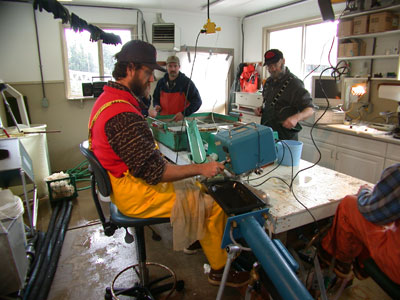NOAA Fisheries News Releases
NEWS RELEASE
July 28, 2009
Sheela McLean, Public Affairs
(907) 586-7032
NOAA marine station celebrates 75 years

Researchers tag steelhead smolts for research at Little Port Walter. Photo: NOAA Fisheries.
NOAA’s Little Port Walter Marine Station on Baranof Island in Southeast Alaska is celebrating 75 years of fisheries research. Established in 1934, it is the oldest year-round biological field station in Alaska.
"A record of observations gathered in one place over a long time is extremely valuable science," said Doug DeMaster, director of NOAA’s Alaska Fisheries Science Center. "At Little Port Walter we have long time series of data on salmon, herring and other species that are invaluable for understanding the effects of climate change on our fisheries."
"Little Port Walter researchers have drawn an enduring scientific legacy of that area’s ecosystem while continuing to discover new facts about the climate, biology of marine species, and oceanography of the region," DeMaster said.
Little Port Walter lies in lower Chatham Strait 20 miles from Cape Ommaney and the open Gulf of Alaska. Sashin Creek, a stream used by several species of salmon including steelhead, flows near the marine station.
This summer NOAA scientists and support staff will be researching the feasibility of identifying individual stocks and families of Chinook salmon in fishery harvests. The information would potentially help managers make harvest decisions, rebuild depleted stocks and sort out the geographic origins of the harvested salmon, which would address issues that arise under the U.S./Canada Pacific Salmon Treaty.
Alaska’s next generation of fisheries scientists is gaining experience at Little Port Walter. Five students from the University of Alaska Southeast Design Discover Research program and two students from the Alaska Native Science & Engineering program will be spending a week focused on hands-on research and field research techniques this summer. Little Port Walter staff has also hosted NOAA-funded students from the Holling’s Scholars Program, exposing them to freshwater and marine ecology, aquaculture, long term ocean monitoring, fish physiology, and marine mammal science.
Little Port Walter has maintained an official daily weather record for NOAA’s Weather Service since 1936. It is one of the wettest recording stations in North America, averaging 240 inches of precipitation annually.
In the marine station’s earliest years, research focused on environmental factors that affect freshwater survival of pink salmon. In the following decades, that broadened into research on the ecology, population dynamics, and life histories of other salmon, steelhead, marine fishes, and invertebrates. Little Port Walter researchers have also studied shrimp, herring, rockfish, marine corals, oceanography, climatic changes, effects of droughts and floods on fish stocks, and the intertidal ecology of spawning salmon.
In the early 1970's interest turned towards salmon hatcheries. NOAA, the Alaska Department of Fish and Game, and private hatchery groups worked together on enhancing the production and survival of salmon stocks. Hatchery technologies developed at Little Port Walter include floating raceways, estuarine net pens for short term rearing of salmon fry, substrate incubation systems, smolt vaccination for improved marine survival, and stocking salmon fry in hanging lakes for natural smolt production.
Little Port Walter station includes a marine dock and float system and a permanent fish counting weir at the mouth of Sashin Creek, a warehouse, two residences, the three-story headquarters building (with a galley, dormitory, small laboratory, radio room, and apartment), two wet laboratories, an experimental fish culture system with floating freshwater raceways and marine net pens, a generator building, an oil storage and containment structure, an incinerator, a NOAA weather station, and other support buildings.
Wakefield Fisheries built a processing plant at Little Port Walter in 1917. In 1934 the Bureau of Fisheries began salmon research there and in 1938 Congress passed legislation establishing a fisheries laboratory at the site. By the late 1930’s the Bureau and Civilian Conservation Corps were at work building a permanent weir on Sashin Creek. In 1940 the main headquarters structure, the ‘White House’, was built with help from the Civilian Conservation Corps and the U.S. Forest Service, using bricks from the abandoned Fisheries plant. The ‘White House’ was last renovated in 2004.
At least one fisheries technician has occupied Little Port Walter year-around since 1940. Currently two NOAA employees are on-site year around, with other scientists, contractors, volunteers and personnel from other agencies or the private sector swelling the ranks to about 20 individuals at peak times. In the past 75 years Little Port Walter research has produced over 200 scientific publications, documents, and reports on marine resources of this region.
More information about Little Port Walter can be found at: http://www.afsc.noaa.gov/ABL/MSI/msi_lpw.htm.
NOAA understands and predicts changes in the Earth's environment, from the depths of the ocean to the surface of the sun, and conserves and manages our coastal and marine resources. Visit www.noaa.gov. To learn more about NOAA Fisheries in Alaska, visit alaskafisheries.noaa.gov or: www.afsc.noaa.gov.